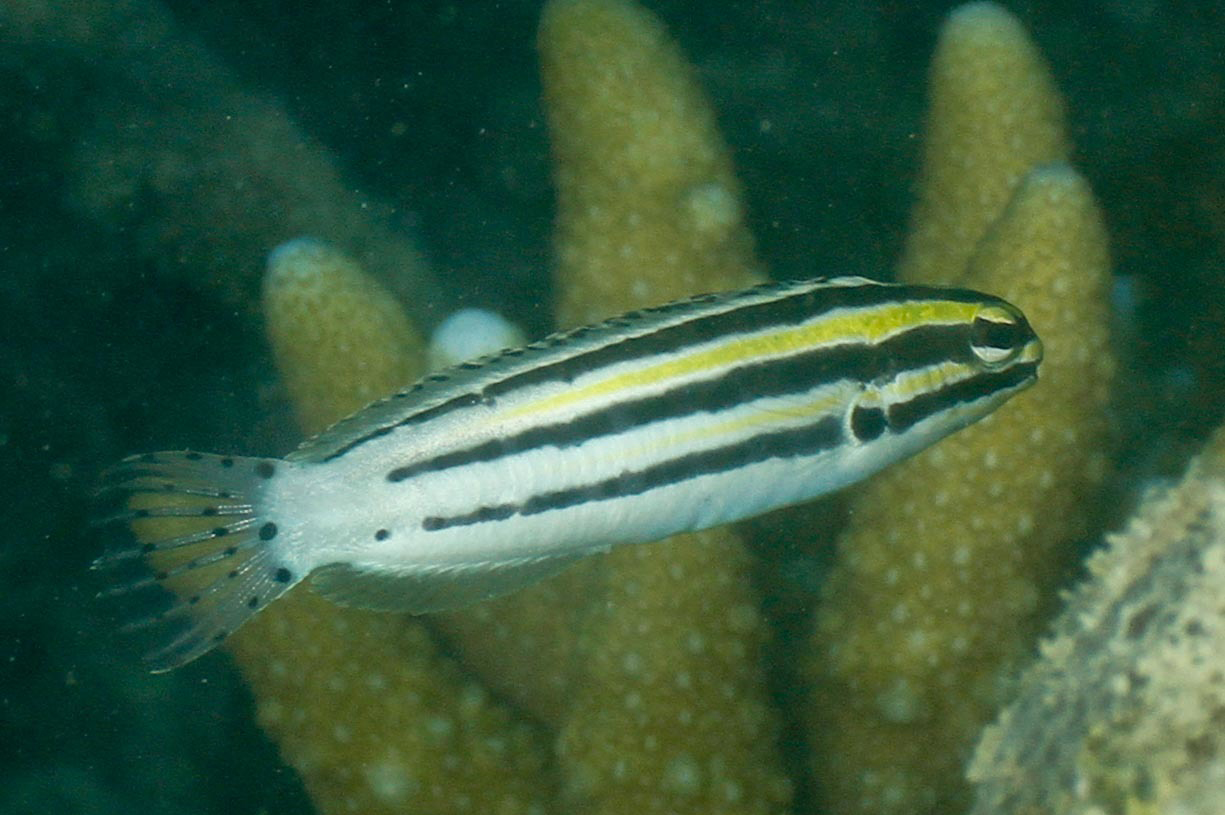- Classification
- ACTINOPTERYGII
- PERCIFORMES
- BLENNIIDAE
- Meiacanthus
- grammistes
Linespot Fangblenny, Meiacanthus grammistes (Valenciennes 1836)
Other Names: Black-banded Blenny, Grammistes Blenny, Line-spot Harp-tail, Line-spot Harptail Blenny, Striped Blenny, Striped Fangblenny, Striped Poison-fang Blenny

A Linespot Fangblenny, Meiacanthus grammistes, on Wilsons Reef, Great Barrier Reef, Queensland, June 2015. Source: Ian Shaw / iNaturalist.org. License: CC BY Attribution-NonCommercial
Summary:
A whitish fangblenny with a yellow head and upper body, three black stripes (sometimes made up of spots) along the body, a dark submarginal band along the dorsal fin (made up of dark markings on the membranes between the spines) and black spots on the caudal fin.
Meiacanthus fangblennies have a pair of grooved venomous canines in the lower jaw associated with venom glands - used for defence - allowing them to forage out in the open.
The Linespot Fangblenny is mimicked by the Shorthead Sabretooth Blenny, Petroscirtes breviceps and juvenile Scolopsis bilineata.
Video of a juvenile Monocle Bream mimicking a Linespot Fangblenny
Meiacanthus fangblennies have a pair of grooved venomous canines in the lower jaw associated with venom glands - used for defence - allowing them to forage out in the open.
The Linespot Fangblenny is mimicked by the Shorthead Sabretooth Blenny, Petroscirtes breviceps and juvenile Scolopsis bilineata.
Video of a juvenile Monocle Bream mimicking a Linespot Fangblenny
Cite this page as:
Bray, D.J. 2021, Meiacanthus grammistes in Fishes of Australia, accessed 06 Jul 2025, https://fishesofaustralia.net.au/home/species/4738
Linespot Fangblenny, Meiacanthus grammistes (Valenciennes 1836)
More Info
|
Distribution |
Burnet Island, Western Australia, around the tropical north to Moreton Bay, Queensland; also Ashmore Reef in the Timor Sea. Elsewhere the species occurs in the tropical, west Pacific, from Indochina to Papua New Guinea, north to Ryukyu Islands, south to Australia. |
|
Feeding |
Their well-developed swim bladder and venomous fangs allow Meiacanthus fangblennies to forage out in the open. |
|
Biology |
Species of Meiacanthus are unique amongst fishes if having have grooved dentary canines in the lower jaw associated with venom glands. |
|
Species Citation |
Blennechis grammistes Valenciennes in Cuvier & Valenciennes 1836, Histoire Naturelle des Poissons 11: 284. Type locality: Java. |
|
Author |
Bray, D.J. 2021 |
|
Resources |
Linespot Fangblenny, Meiacanthus grammistes (Valenciennes 1836)
References
Allen, G.R. 1993. Fishes of Ashmore Reef and Cartier Island. Records of the Western Australian Museum, Supplement 44: 67-91
Allen, G.R. 1997. Marine Fishes of Tropical Australia and South-east Asia. Perth : Western Australian Museum 292 pp. 106 pls.
llen, G.R. & Erdmann, M.V. 2012. Reef fishes of the East Indies. Perth : Tropical Reef Research 3 vols, 1260 pp.
Allen, G.R. & Swainston, R. 1988. The Marine Fishes of North-Western Australia. A field guide for anglers and divers. Perth, WA : Western Australian Museum vi 201 pp., 70 pls.
Casewell, N.R. et al. 2017. The Evolution of Fangs, Venom, and Mimicry Systems in Blenny Fishes. Current Biology 27: 1–8 http://dx.doi.org/10.1016/j.cub.2017.02.067 Abstract
Kuiter, R.H. 1992. Tropical Reef-Fishes of the Western Pacific, Indonesia and Adjacent Waters. Jakarta : PT Gramedia Pustaka Utama 314 pp. pls.
Randall, J.E., Allen, G.R. & Steene, R. 1990. Fishes of the Great Barrier Reef and Coral Sea. Bathurst : Crawford House Press 507 pp. figs.
Randall, J.E., Allen, G.R. & Steene, R. 1997. Fishes of the Great Barrier Reef and Coral Sea. Bathurst : Crawford House Press 557 pp. figs.
Smith-Vaniz, W.F. 1976. The saber-toothed blennies, tribe Nemophini (Pisces : Blenniidae). Monographs of the Academy of Natural Sciences of Philadelphia 19: 1-196 figs 1-179
Smith-Vaniz, W. F., Satapoomin, U. & Allen, G.R. 2001. Meiacanthus urostigma, a new fangblenny from the northeastern Indian Ocean, with discussion and examples of mimicry in species of Meiacanthus (Teleostei: Blenniidae: Nemophini). aqua, Journal of Ichthyology and Aquatic Biology 5(1): 25-43 See ref online
Springer, V.G. 2001. Blenniidae. pp. 3538-3546 in Carpenter, K.E. & Niem, T.H. (eds) The Living Marine Resources of the Western Central Pacific. FAO Species Identification Guide for Fisheries Purposes. Rome : FAO Vol. 6 pp. 3381-4218.
Valenciennes, A. in Cuvier, G.L. & Valenciennes, A. 1836. Histoire Naturelle des Poissons. Paris : Levrault Vol. 11 506 pp. pls 307-343.
Williams, J.T. 2014. Meiacanthus grammistes. The IUCN Red List of Threatened Species 2014: e.T48342154A48389543. http://dx.doi.org/10.2305/IUCN.UK.2014-3.RLTS.T48342154A48389543.en. Downloaded on 12 March 2017.








